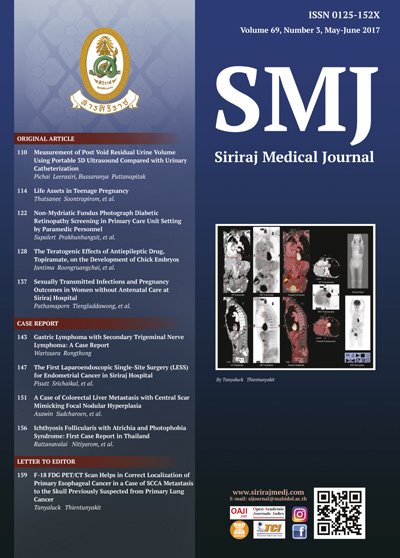Measurement of Post Void Residual Urine Volume Using Portable 3D Ultrasound Compared with Urinary Catheterization
Keywords:
Post-void residual urine volume, BladderScan®, urethral catheterization, elapsed time, pain scoreAbstract
Objective: To find out correlation between the 3D ultrasound and conventional urethral catheterization in terms of measurement accuracy of post void residual urine (PVR) volume, pain score, and elapsed time
among patients attending Urogynecology Clinic, Siriraj Hospital between December 2011 to December 2012.
Methods: With the approval of the institution’s Ethics Committees, a total of 64 participants were enrolled. Participants with conditions that could affect bladder volume, including previous pelvic surgery and radiation, abnormal anatomy of genitourinary system, and contraindications for urethral catheterization were excluded. A questionnaire asking about demographic data and clinical presentation of each participant was completed. PVR volume was measured using the BladderScan® (BVI-9400), followed by urethral catheterization. Differences between PVR volume and elapsed time in both procedures were determined. At the end of each procedure every participant
was asked to rate the pain score, from 0 (no pain) to 10 (most severe pain), according to the Visual Analog Scale.
Results: The mean age was 60 years old, ranging from 33 to 81. The mean body mass index (BMI) was 26.5 kg/m2± 4.1. The PVR volume measured by the BladderScan® was significantly correlated with that measured by the conventional catheterization with the correlation coefficient of 0.92 (p<0.001). The mean pain score in the BladderScan® group was obviously less when compared with that of the catheterization group (0.59 ± 1.19 vs 3.00 ± 2.07; p<0.001). The mean time used in the BladderScan® group was significantly lower than that in the catheterization group.
Conclusion: The BladderScan® had high correlation, time saving and less pain compared to conventional urethral catheterization for measurement of the post-void residual urine volume.
Downloads
Published
How to Cite
Issue
Section
License
Authors who publish with this journal agree to the following conditions:
Copyright Transfer
In submitting a manuscript, the authors acknowledge that the work will become the copyrighted property of Siriraj Medical Journal upon publication.
License
Articles are licensed under a Creative Commons Attribution-NonCommercial-NoDerivatives 4.0 International License (CC BY-NC-ND 4.0). This license allows for the sharing of the work for non-commercial purposes with proper attribution to the authors and the journal. However, it does not permit modifications or the creation of derivative works.
Sharing and Access
Authors are encouraged to share their article on their personal or institutional websites and through other non-commercial platforms. Doing so can increase readership and citations.











